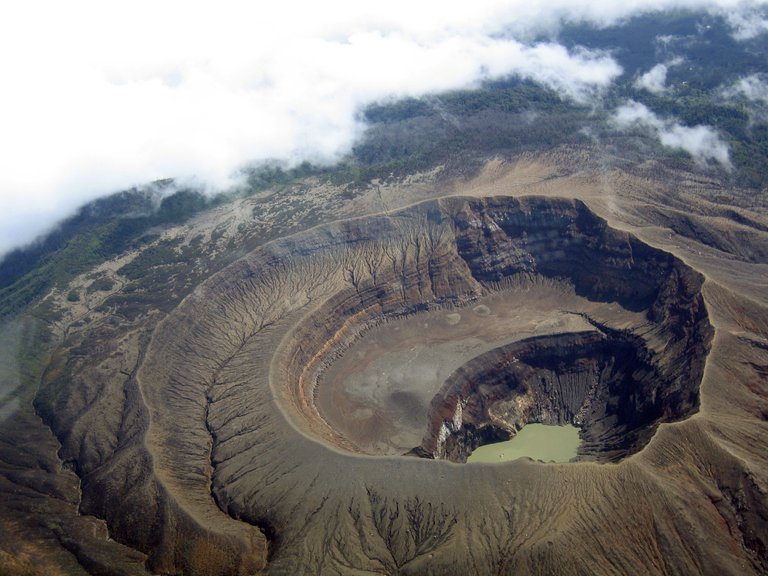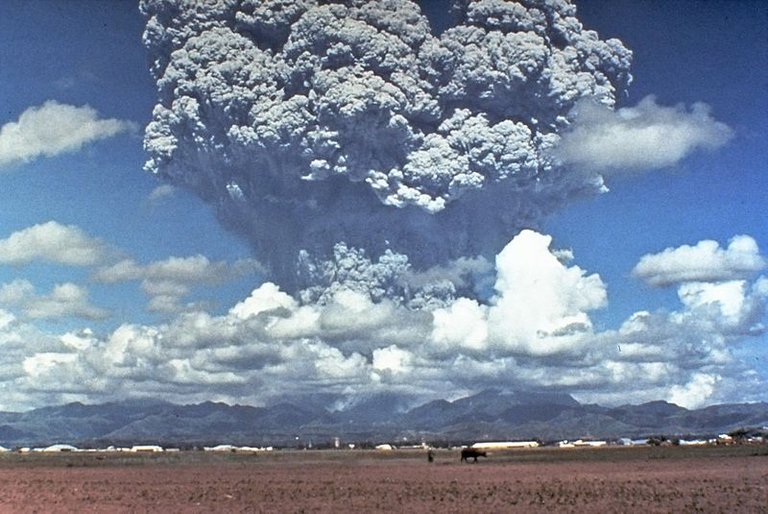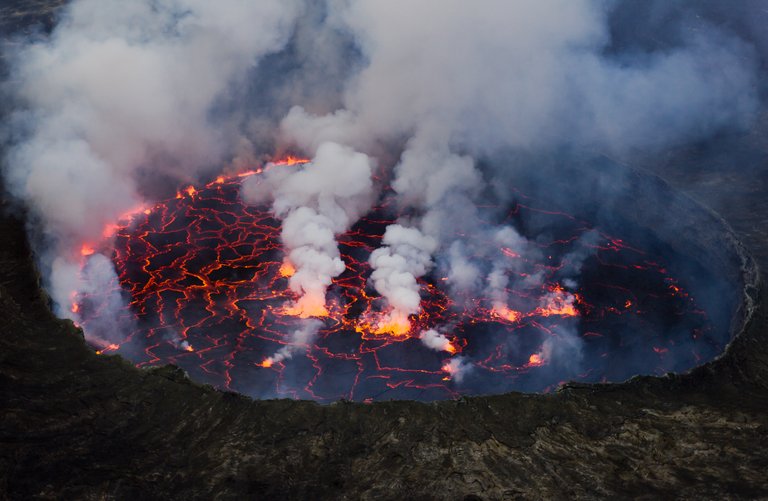Hello everyone!
How are you doing today? I hope you're having a great day. Everything is good as far as I'm concerned. After launching this new series and sharing broad information regarding the Geological Cycle and its Subcycles in a previous post, I am now ready to share the second part of the series with you guys. I do not mean to waste your time though, so let's get this started!
Second post regarding the scientific field of studying the Earth's interior structure and the way its structural layers were shaped. This time I'm taking the chance to share general technical information regarding Plutonism and Volcanism. We will discuss the flow of magma and share information regarding the different forms in which it can be found in nature. We will also talk about plutonic magmatites and take a deeper look at the two main categories of plutonites, so stay focused!
As the title reads, let's always keep in mind that this is an introductory series. What does that mean? Well, it basically means that I will be trying to present general introductory information regarding Geology in a simplified manner so that nobody gets bored to death. It is always easier to learn while having fun and there's a high chance of learning a thing or two by reading through this blog, so stay tuned!

Introduction
As magma flows from the Earth's interior towards the surface it induces a wide range of geological phenomena. Such phenomena are classified according to the distance of their zone of effectiveness from the Earth's crust. In cases where magma infiltrates the Earth's crust but fails to make it to the surface, the process of magma differentiation gives birth to ideal conditions for metallogenesis and we are talking about Plutonism. On the contrary, the term Volcanism is used to describe all geological phenomena that occur on the natural terrestrial surface, such as the creation of volcanoes and hot springs.
All sorts of igneous geological activities take place below the Earth's surface during the process of Plutonism and therefore this is a spectacular show that we can't actually enjoy. However that is not the case with volcanic activity, as we are actually blessed with the ability to witness and even record this natural wonder as soon as molten rock material traveling through the planet's crust reaches the surface. Okay, it might not be that much of a pleasant experience if you live nearby. It is true, volcanic eruptions can impact our civilization and have already done so in the past. It is safe to say that human activity and development is directly affected by such geological phenomena.
The term Volcanism refers to all sorts of geological activities correlated with the flow and transportation of igneous material from the planet's interior towards the natural terrestrial surface. This motion takes place inside cracks that are known among Geologists as natural pipes that infiltrate the upper Mantle and in many cases even the Mantle, allowing massive quantities of liquids and gases to reach the upper layers of the planet and in various cases even the natural terrestrial surface. And this is basically how igneous fragmented rocks gather around volcano craters, shaping the planet's surface and decorating it with unique and beautiful crystallized rocks.
Volcanoes are created and formed when energy generated by inductive currents flowing from the Earth's core towards the surface hits the upper layers in the form of pressure and shatters the overlaying rock formations. That is the main reason why the natural terrestrial surface close to the crater is slightly curved. The presence of dilated water vapor plays an important role in the creation of craters by assisting the flow of magma towards the surface. That also explains why massive amounts of water vapor are always emitted into the atmosphere during volcanic eruptions. It is estimated that water vapor concentration in magmatic gases has an average value of 80%.

Magma
Magma is actually the result of the combination of molten rock formations and materials situated in the outter core and in some cases in the lower levels of the mantle. It is a mixture of liquids and gases situated at a temperature of 500 - 1200 degrees Celcius that is mainly comprised of alkaline salts. Hydrogen is one of the gases present at a percentage of approximately 5%, whereas water is also present at a percentage of 8% of the mixture's liquids. Magma can be classified into four main categories according to the various levels of silicon concentration and we should always keep in mind that the chemical composition of magma is not the same for all categories. The four types of magma are demonstrated below:
- Acidic Magma (Silicon Concentration > 66%)
- Intermediate Magma (53% < Silicon Concentration < 66%)
- Basic Magma (46% < Silicon Concentration < 53%)
- Alkaline Magma (Silicon Concentration < 45%)
The creation of this mixture that is known as magma is highly assisted by the presence of vast amounts of heat, which is a factor that causes the temperature to rise at such high levels, making materials reach their melting point and therefore destroying rock formations. The transmutation of radioactive elements situated enclosed inside the rocks is another factor that causes the temperature to rise. This process results in the creation of magma in the outter layers of the mantle and even in the deepest layers of the crust in some cases. The state in which magma can be found is highly dependent on the various kinds of minerals with different melting points that it is comprised of. Pressure plays an important role as well and depends on distance from the natural terrestrial surface.

The flow of magma from the Earth's interior towards the natural terrestrial surface is assisted by the presence of gases and water which make it much lighter than surrounding rock formations, and the high pressure due to large distance from the planet's surface. As a result, it is transported through gaps that are known as cracks which form rifts and allow this hot and light, fluid mixture to move upwards. The mixture's chemical composition is altered significantly as it moves upwards, mainly due to the fact that a lot of water is released in the form of water vapor. Once our hot mixture makes its way to the natural terrestrial surface we have hot lava to enjoy. Or maybe not.
Magma in its final form is usually born in the upper layers of the mantle due to the fact that tensile forces acting in some regions of this layer result in the reduction of pressure which in return lowers the melting point of materials situated in the mantle. This is the exact process that gives birth to magma, when the presence of various oxides, fluorine, sulfur and chlorine compounds that are necessary for the creation of magma is guaranteed. It is worth noting at this point that the solidification and crystallization of magma takes place mainly inside the Earth's interior, however there are also crystals that are formed on the natural terrestrial surface. When the process of crystallization takes place inside the crust, the magmatic rocks produced are called plutonites.

Igneous Rock Formations
As explained above, the flow of magma from the Earth's interior towards the natural terrestrial surface through cracks and natural pipes known as rifts results in the crystallization of the mixture, which in return gives birth to the creation of new rocks that vary in size and shape. Those new rock formations can be classified into two main categories, depending on whether or not the solidification process took place on the natural terrestrial surface. Molten material in the form of lava that undergoes the process of crystallization on the natural terrestrial surface gives birth to rock formations known as volcanites and this is one of the two categories mentioned above. However, in this episode we will be focusing on plutonites, also referred to as plutonic magmatites, which is the second category of igneous rock formations.
If you have been following then I guess it is quite obvious by now that plutonites are igneous rock formations that are created when the process of crystallization and solidification of magma takes places below the Earth's surface and particularly in the crust. Plutonites can be classified into conformable and discordant plutonites, which are two broad categories created based on the way they infiltrate neighboring structural layers and their direction of motion in relation to those rock formations. Conformable plutonites move parallel to the structural layers' direction, whereas discordant plutonites intersect the crust's structural layers vertically. The differences in the behaviour of those types of igneous rock formations inside the crust induces the creation of rock formations of various shapes and sizes. Let's take a deeper look at each one of those categories of plutonites.
_at_Rushikonda,_Visakhapatnam.jpg)
Conformable Plutonites
Bedrocks are one of the most significant types of conformable plutonites. These conformable plutonites are slaty rocks which vary from a couple centimeters to more than 300 meters in thickness in certain cases. They expand horizontally and occupy surfaces with an area of up to several square kilometers, while it is also worth noting at this point that there is a wide range of different bedrocks with chemical compositions that can vary from acidic to alkaline. However flat shaped bedrocks are definitely not the norm, as there are also plutonites with various different shapes.
It is therefore safe to say that there is a huge variety of conformable plutonites, from bell shaped plutonites found in large formations that can be several kilometers long to basined conformal plutonites which can occupy areas of up to 150 square kilometers. It is worth noting at this point that there is no scientific data available regarding the way various types of conformable plutonites were formed as a result of their interaction with magma, due to the fact that the deep side of most of those rock formations has never been observed. Some of the world's most significant metal deposits are situated on such formations.
Discordant Plutonites
Discordant slaty plutonites are also referred to as non conformable plutonites. These are rock formations which can be described as volcanic veins and therefore expand vertically and can be found kilometers below the natural terrestrial surface. Discordant plutonites are mainly comprised of granite rocks and can be more than 500 kilometers long and more than 200 kilometers wide, forming the cores of the world's mountain ranges. However we should always keep in mind that discordant plutonites also include a huge variety of smaller formations most of which are created as discordant bulges of primary magmatic bodies. These bulges expand downwards and connect with the main granite formations.
Detached parts of the neighboring rock formations are completely dissolved after sinking inside the molten mixture flowing from the planet's interior towards the natural terrestrial surface. Various types of discordant plutonites are produced in cases when not all parts are completely dissolved, after the crystallization process is completed and all molten material is cooled down. These fresh formations are naturally disconnected from the magma chamber thanks to the presence of rifts which allow magma to flow through and remove parts of the crystallized rocks. This is also one of the ways in which magma reaches the natural terrestrial surface.
_2_(18904721766).jpg)
Alright everyone, that's it for now! Thank you for being here and taking the time to read through this blog. I sincerely hope you had fun and did learn something new. That means the second part of this Geology series has come to an end. Please do let me know if there are any questions regarding this blog in the comments below. I will certainly do my best to provide prompt responses. I have more episodes coming out within the next few days. Follow me and stay tuned for more engineering blogs. :)

IMAGE SOURCES:
REFERENCES:
University Textbooks & Course Lectures:
Γενική Γεωλογία Ι/ General Geology I -RONDOGIANNI T.(National Technical University of Athens, School of Rural & Surveying Engineering, Course Lecture Notes)
Γενική Γεωλογία - Γεωμορφολογία, Πανεπιστημιακές Εκδόσεις Ε.Μ.Π. /General Geology - Geomorphology, University Publications N.T.U.A. - DIMAKIS, GKANIS, SAKELLARIS, CHRYSANTHOPOULOS (National Technical University of Athens,School of Rural and Surveying Engineering, University Textbook)
Internet Links:


Thank you for your attention!
Hope you enjoyed this post and did learn a thing or two.
Follow me and stay tuned for more engineering blogs.
Highest Regards
@lordneroo
lovely write @lordneroo
thank you for sharing
resteem
Thanks for passing by! :)
Oh my @lordneroo what a post! It feels like you have covered everything already 😅
I became interested in volcanoes when my husband and I, a decade ago, bought a little wooden cabin only a few Kilometers away from one! That was in Chile.
So yeah, I will have to agree with you. Sometimes the volcano would emit a huge tower of smoke - by the way, never knew the concentration of water vapor in magmatic gases was so high! - normally the wind would blow it towards Argentina and there would be no damage on our side. But, then, they became more and more frequent.
I particularly liked the part you explored Rock Formation :)
Your posts are SO good Lordneroo, and so well-written too!
Take care 😘
Oh my dear @abigail-dantes, I'm so humbled by your kind words! Thank you so much for the support!
Oh yeah the concentration of water vapor in those gases is indeed so high. I was surprised when I found out about that too, so I can see where you're coming from. Geologists consider volcanoes to be the devil on Earth. :P Just imagine that one of the most significant pros of volcanic activity is the fact that it enables us to possibly predict the next disaster. It's like there is nothing we can do so we are just happy to know when we're going to start running around like mice.
Thank you so much for being here!
Hi @lordneroo!
Your post was upvoted by utopian.io in cooperation with steemstem - supporting knowledge, innovation and technological advancement on the Steem Blockchain.
Contribute to Open Source with utopian.io
Learn how to contribute on our website and join the new open source economy.
Want to chat? Join the Utopian Community on Discord https://discord.gg/h52nFrV
Thank you so much for the support!
Being myself professional geophysicist- I love every bit of yr article. I reminds me my university days .
Hello @prameshtyagi, thank you so much for your kind words! Glad you liked my work and more than glad it reminded you of your university days! Take care!
So it's basically... hot goo above or below the surface, and hard stuff made above or below the surface, and hard stuff formed below the surface that went up or sideways? And the goo is classified based on how much of a motherboard it is? Is that why that enargite sort of looks like silicon?
I couldn't have said it better myself!
Hope you're having a great day, mate! Thanks for passing by!
:D I am, and I hope yours is awesome! See you around!
apisteuto post... kathe soy post einai kalitero apo to allo..
spoudazeis kayi tetpio?
Τhanks Nick! Exw spoudasei engineering :)
That was really a nice way to put things ! I remember watching a document when i was a kid about the Santa Maria volcano which took away about 5000 lives, i had a volcanic-phobia of some sort since then ! Its really nice to look from a different angle for a change...
Hey @fancybrothers, thank you for stopping by. I'm glad if you liked my work mate! Hope you got over your phobia! Take care :)
This is one of those articles you read where you humbly sit down and earnestly take notes. As you literally covered almost everything, there is nothing to add or take away. It is just perfect.
Bravo! @lordneroo, Bravo!!
Thank you for the kind words @agbona! :)
Have a great day!
✌
nice to know about geology though i am not so much interest in this but the post is really helpful and knowledgeable.
Thanks for taking the time to read this @simply777! Have a great day!
INTRODUCTION TO GEOLOGY - PLUTONISM & VOLCANISM has been resteemed by the @resteemmuse!
Thanks for the resteem!
You're very welcome! The @resteemmuse is a test experiment. I'm going to evolve it and provide an update on the blog once this is complete. https://steemit.com/resteemmuse/@sutter/update-coming-to-the-resteemmuse-that-will-include-sidebar-widget-for-steemit-feed
Alright, I see! Thanks for the information and of course, thanks for the support! Wish you every success with @resteemmuse. Have a good day!
You received a 10.0% upvote since you are not yet a member of geopolis and wrote in the category of "geology".
To read more about us and what we do, click here.
https://steemit.com/geopolis/@geopolis/geopolis-the-community-for-global-sciences-update-4
Thanks for the upvote!
STOPThanks!